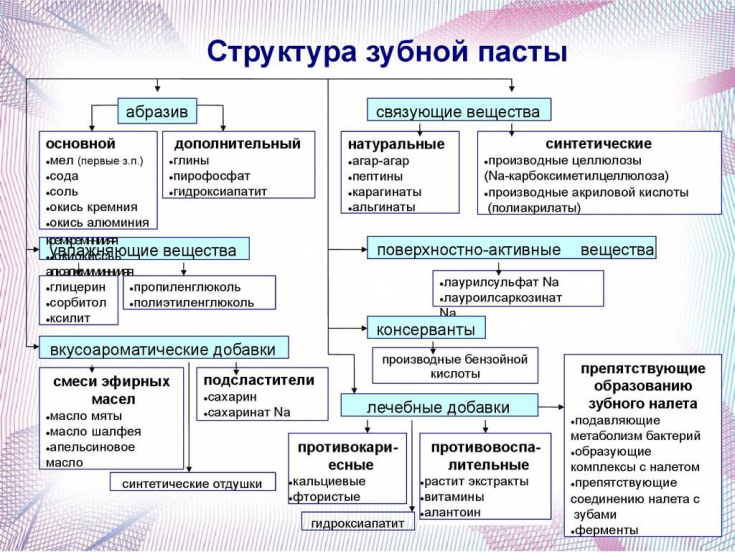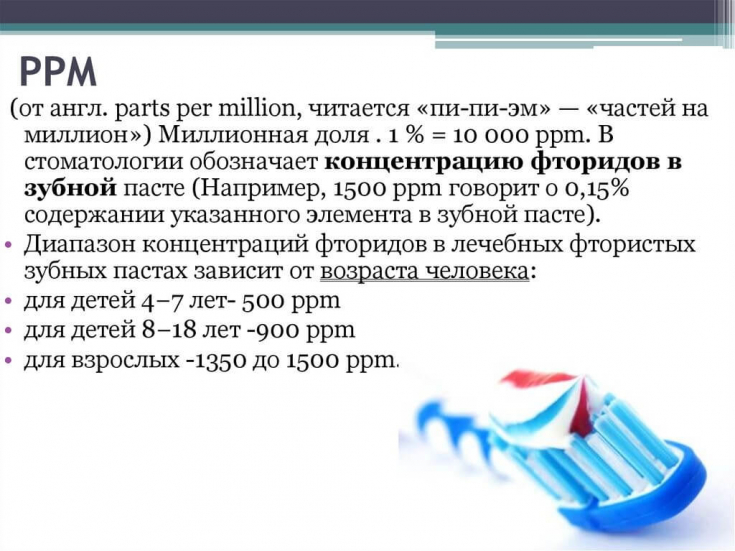Caries − is a disease of the hard tissues of the tooth caused by an imbalance of the mineral composition, which consists in demineralization of the structure of the teeth under the influence of organic acids, which are formed as a result of the interaction of cariogenic bacteria in dental deposits and fermented carbohydrates (mainly sugars).
Find out in the article on estet-portal.com about the results of studies regarding the reduction of carious lesions in using fluoridated toothpaste.
- Fluorinated toothpaste as a factor in tooth remineralization
- Increased risk of fluorosis with fluorinated pastes
- Study on the effect of fluoridated toothpasteyou
Fluorinated toothpaste as a factor in tooth remineralization
The formation of dental caries is influenced by the susceptibility of the tooth surface, the bacterial profile, the amount of saliva and its properties, as well as the presence of fluoride, which causes:
- remineralization of carious areas in the early stages;
- reduces the solubility of tooth enamel;
- Protects enamel from demineralization when exposed to acidic pH.
Follow us on Instagram!
Today, the use of fluoridated paste remains one of the key strategies in dentistry to prevent dental caries.
There are also additional fluoride delivery vehicles such as fluoridated water, milk, gels, varnishes, and the like.
Brushing Recommendations: Brushing is usually done with a toothbrush and fluoridated toothpaste for 2 minutes twice a dayMon.
Brushing with fluoride toothpaste is the most common method of preventing cavities, and the use of fluoridated toothpaste is mainly associated with a reduction in the incidence of cavities in many countries.
Increased risk of fluorosis with fluorinated pastes
However, there is concern that dental fluorosis, enamel defects developing in young children who constantly consume excessive amounts of fluoride during the period of tooth formation (up to 6 years).
Fluoride concentration is varied, and various fluorine compounds − alone and in combination, including:
- sodium fluoride;
- sodium monofluorophosphate;
- amine fluoride;
- stannous fluoride.
Enamel discoloration: a wake-up call
range from 1000 to 1500 parts per million (parts per million - ppm). There is no limit on the minimum concentration of fluoride, but
the maximum concentrationof fluoride for toothpaste depends on the region of residence, the age of the patient and other parameters. Toothpaste
with 5000fluoride can be given to patients with: high risk of caries at age 16 and over;
presence or high risk of root caries;- dry mouth;
- orthodontic appliances;
- Those who are on a cariogenic diet or taking medication.
Toothpaste containing  high concentrations of fluorine
high concentrations of fluorine
(an enamel defect caused by chronic consumption of excessive amounts of fluoride during tooth formation) ). What does bleeding gums mean
o 0.07mgF / kg body weight. Research on the effect of fluoridated toothpaste
For primary teethin young children:
500 ppm F fluoride toothpaste reduces carious lesions compared to placebo (moderate evidence). Chalky stains on teeth: what do they mean and how to get rid of it
Preventive anti-caries effect of 550 and 1055 ppm fluoridated toothpaste: brushing with 1055 ppm F toothpaste reduces caries compared to 550 ppm F toothpaste.
 For permanent teeth in children and adolescents:
For permanent teeth in children and adolescents:
The side effects of toothpaste have only been evaluated in a small number of studies. Effects such as soft tissue damage and tooth staining were minimal.
How to keep a beautiful oval of the face after tooth extraction
For adult permanent teeth: The use of 1000 or 1100 ppm fluoridated toothpaste reduces the progression of caries compared to non-fluorinated toothpastes in adults of all ages.
In general, there is some evidence of a strong relationship between fluoride concentration and the caries-preventive effect of fluoride in toothpastes, with the magnitude of the caries-preventive effect increasing with increasing fluoride concentration.
The choice of concentration of fluoride pastes for young children should be balanced against the risk of developing fluorosis.






